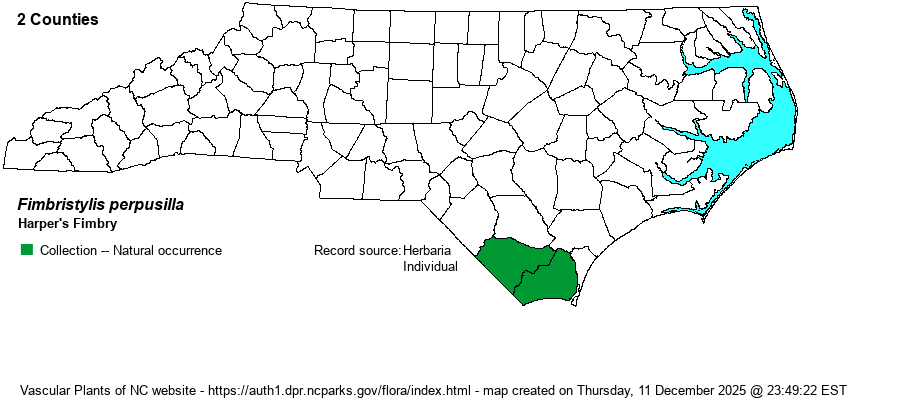| Author | R.M. Harper ex Small & Britton | |
| Distribution | Southern outer Coastal Plain only. The few NC records are from exposed shores of the Waccamaw River.
Mostly Coastal Plain, DE to northeastern SC, southwestern GA, and AL; disjunct inland to KY, TN. This is a globally very rare species (G2), with a small range. | |
| Abundance | Very rare. The NCNHP database has 4 records, all from the Waccamaw River, with only one site having a sizable current population. This is a State Threatened species. | |
| Habitat | Exposed sandy shores of a blackwater river in NC. In other states, can also occur in drawdown zones of depression ponds. | |
| Phenology | Flowering and fruiting July-September, depending on water levels. | |
| Identification | This is a tiny, tufted, slender, annual fimbry; the stems in NC plants are mostly just 2-4 inches tall, with 3-6 spikelets at the summit. The seeds are banana-shaped, unlike all other fimbries. | |
| Taxonomic Comments | In some older literature, it may have been confused with F. vahlii, an alien which also occurs in NC (historically at least). Seeds of the latter are obovoid.
Plants of the the genus Fimbristylis are very small to tall (3+ feet), with most leaves in a basal tuft, and an open, branched, terminal inflorescence. The spikelets are various shades of rufous, chestnut, or brown (due to the color of the scales) and resemble tiny pinecones. Important key characters include size, shape, and ornamentation of the achenes (seeds); see also other characters used by Weakley (2018). Godfrey & Wooten (1979) have excellent drawings and descriptions. | |
| Other Common Name(s) | None | |
| State Rank | S1 | |
| Global Rank | G2 | |
| State Status | T | |
| US Status | | |
| USACE-agcp | OBL link |
| USACE-emp | OBL link |

